 |
Bhutan Economy |
|
 |
Bhutan Information |
|
|
 |
|
The Rice Bowl of Trashigang - Agriculture development
|
| Thimphu
Valley, wet farming |
| More
recently agriculture development has had a significant impact on the
geog's rice yield through the introduction of new varieties, chemical
fertilisers and better management practises. Statistics provided by the
dzongkhag agriculture sector show that rice production in Radhi shot up significantly in the last decade. In 1990 an acre produced about
900-kilogramme. Today production is
about 1,500 to 2,000- kilogramme an acre,
an increase of about 20-kilogramme an acre annually. |
|
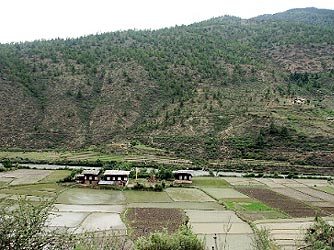 |
The field crop sector
under the renewable natural resources research centre (RNRRC)-Khangma has
successfully tried and introduced new varieties such as Kumal, and Yusirey
Kap and Map, a cross-breed of the local and high yielding Japanese
variety.
The Kumal
variety, from Nepal, introduced last year yielded immediate results
with production exceeding over 700 MT, much higher than the regularly cultivated
local "sobrang" variety. Radhi produced about 2,549 MT of Kumal during
its "trial" run compared with 1,841MT of local rice.x
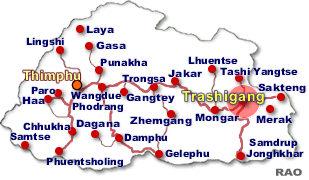 |
| All
in all, Radhi cultivates about 10 improved and local varieties depending
on the altitude. Meanwhile, five other PP (Paro population) lines (products
of a rice cross breeding programme), tried last year failed to make an
impact owing largely to intensive labour required during its harvest. |
|
The
experiment carried out jointly by the agriculture sector and RNRRC Khangma
saw that while the high altitude PP lines fared better in yield, the quality
was a failure, and it required more hands in threshing the hard grains.
Radhipas,
however, still prefer cultivating the local mid-altitude varieties such
as Sung Sung and Sobrang for its aroma and taste. It is also the demand
by consumers. "These were varieties cultivated since a long time ago,"
says the Radhi Gup, Kulung. "Then, Changkhar, Pakhaling, and Dungpaling,
were the main villages involved in rice cultivation."
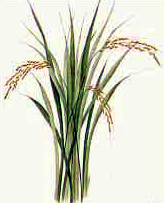 |
| But
not even Kulung knows why and how Radhi became a major rice producer. "Even
as a child I remember that we cultivated rice," says Kulung. "It was mostly
for home consumption and to barter with neighbouring geogs. Today, of course,
people cultivate rice to sell in eager markets in Thimphu and Trashigang."
Agricultourists
think it was because of the suitable climate, terrain and (previously)
adequate water resources to irrigate the paddy fields. With its gentle
slopes rising from 1,200 m to 2,400 m and a sub-tropical climate,
Radhi is suited for rice cultivation. At the northern tip of the geog there
are several lakes which overflow during the monsoons and feed the
two rivers that run on either side of the geog. |
|
 |
| Ura
Valley, Mongar, dry farming |
| For
an otherwise dry dzongkhag where Kharang is the staple diet, cultivating
rice was a matter of pride and a sign of prosperity. "Not long ago, eating
rice for meals was a rarity," says a restaurant owner in Trashigang. "Having
rice on the menu for just one meal a day had to be a special occasion like
Losar." He said that the import of cheap rice slowly began to change people's
food habits. |
|
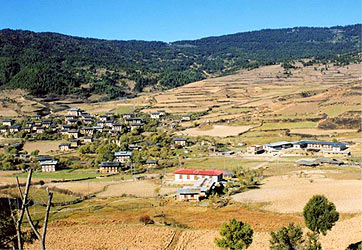 |
The construction of motor roads and the setting up
of FCB agents penetrated even the remote villages providing adequate imported
rice at an affordable price. Local rice is still preferred over what is
available from shops for its taste and fragrance.
Civil
servants in the dzongkhag, hotels, and other private individuals place
orders in advance with Radhi farmers for the rice, or buy from sellers
who visit the Trashigang town with their produce. The rice sells at
about Nu 25 a kilogramme in local markets, cheaper than the high quality
imported rice. A young hotelier in Trashigang town told that, on an average,
his hotel consumed 100-kilogramme of rice a month of which three fourth
was rice from Radhi.
But
the status as the major rice supplier in the dzongkhag has come at a cost. The
high demand for rice from places as far as Kangpara in south Trashigang
fuelled wet land conversion in the geog, say researchers at RNRRC Khangma.
According to the recent cadastral survey almost 50 per cent or 1, 1,057.93-hectare
of the geog is wet land. Today the geog is bereft of forest cover and has
been experiencing landslides for more than a decade. The
Yudiri which flows between Phongmey and Radhi and Chongdiri which flows
on the other side of the geog wash away tonnes of fertile soil every summer.
Water and fuelwood, which was never a problem in the past, is a major concern
today although this has been considerably eased with development schemes,
roads and electricity connections.
With watershed
management and land degradation control, agriculture specialists believe
that there is still scope to further increase rice yield given its suitable
climatic conditions. For example farm mechanisation is still very limited
in Radhi. Farming is carried out in the traditional way, with oxen and
yoke. The only breakthrough was the introduction of an improved version
of the plough in 1997.
Resembling the old plough, the improved metal plough allows the farmer
to stand up straight while tilling the land and the metal blades cut through
the soil more easily. A few farmers own power tillers but it is used more
for transportation than for farming. Terrace farming in Radhi made it
difficult to use power tillers. Otherwise, according to the gup, "farmers
could easily afford power tillers and other such machinery". Agriculturists
say that about 30 per cent of the geog can be mechanised which can save
on the scarce labour and post harvest losses.
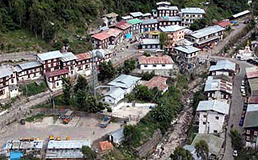 |
| Trashigang |
| With
the increase in population, landholdings have fragmented from about
an average five acres of wetland to several langdos (one langdo is an area
a pair of oxen can plough in a day). Because of this, mass commercial production
on a large scale may not be possible, say agriculture officials because
there is absolutely no area left that can be converted to wetland. |
|
Irrigation
is another problem. Paddy cultivators still depend on rain to irrigate
their fields and other sources remain unexplored. Irrigation canals are
not seen in the entire wetland areas.
| Contributed
by KUENSEL, Bhutan's National Newspaper, 2006 |
 |
| Information on Bhutan |
 |
|







